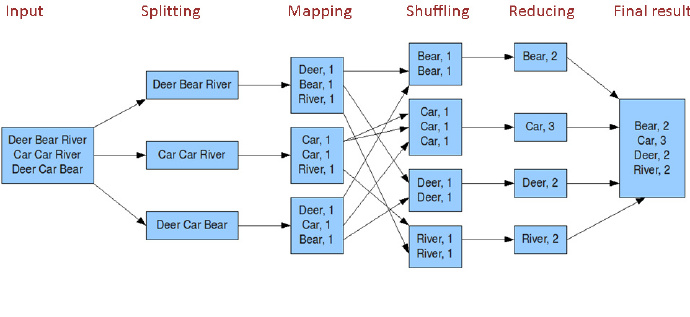Mapreduce基本介绍(一)
2017-01-03 22:09
239 查看
前言:
MapReduce是一个高性能的批处理分布式计算框架,用于对海量数据进行并行分析和处理。与传统方法相比较,MapReduce更倾向于蛮力去解决问题,通过简单、粗暴、有效的方式去处理海量的数据。通过对数据的输入、拆分与组合(核心),将任务分配到多个节点服务器上,进行分布式计算,这样可以有效地提高数据管理的安全性,同时也能够很好地范围被管理的数据。
mapreduce概念+实例

mapreduce核心就是map+shuffle+reducer,首先通过读取文件,进行分片,通过map获取文件的key-value映射关系,用作reducer的输入,在作为reducer输入之前,要先对map的key进行一个shuffle,也就是排个序,然后将排完序的key-value作为reducer的输入进行reduce操作,当然一个mapreduce任务可以不要有reduce,只用一个map,接下来就来讲解一个mapreduce界的“hello
world”。
这个是hadoop自带的一个demo,使用mapreduce来对文本单词数量进行一个统计,所以叫做wordcount,自带的wordcount demo使用的是新版本的api,由于mapreduce做过一次重大的升级,升级后通过yarn进行map,reduce资源的配置,所以我们也使用新的api进行讲解
1、新的api放在:org.apache.hadoop.mapreduce,旧版api放在:org.apache.hadoop.mapred下面,大家写程序的时候可以注意一下
从上面的程序可以看出,上面的TokenizerMapper以及IntSumReducer分别 继承了Mapper以及Reducer这两个类,并重写map()和reduce()方法
key和value是数据读取到的key和value,默认每一行的字节偏移量为key,输入的读取格式可以自定义,一整行的数据为value,比如:
contex则是用于记录key和value,用做上下文关联,比如map输出的值给reducer就是用过context进行关联的
reduce的key和value对应的分别是map输出的key和value,两者的类型是一样的,但是value是以迭代器的形式展现的,也就是说一个key对应的是一组value的值,这其实也挺好想通的,map在生成key和value的时候,会存在相同的key,比如我们统计一片文章里面每个单词出现的次数,以单词为key,value为1生成键值对,由于单词会出现重复,所以reduce输入的value是一个一对多的迭代器
首先是新建了一个configuration对象,configuration对象主要是用来初始化使用,读取hadoop配置文件中的一些配置信息,配置文件有core-site.xml、hdfs-site.xml、mapred-site.xml等,只所以要读取这些配置文件,就是为了告诉这个框架,hdfs在哪里,yarn在哪里等等信息。
otherArgs则是对输入参数的解析,这里一般可以传入输入文件路径,输出文件路径(输出文件路径必须是空的,要不然会报错),而且这些路径都是hdfs上的路径,hdfs和mapreduce天生好基友,不过一般会使用一个自带的工具类来做这件事情,这里不详细讲解。
接下来就是创建一个job作业,运行一个mapreduce应用,就会提交一个job作业,map和reduce则是一个个task,在提交job之前,要先对job进行一个设置
setJarByClass用于设置主要工作类
setMapperClass用于设置Mapper类,就是map的实现类
setReducerClass用于设置Reducer类,就是reduce的实现类
setOutputKeyClass和setOutPutValueClass分别用于设置输出的key和value的类型
这两个就是为了指定输入文件和输出文件的路径
最后一步就是为了提交job,并开始处理
mapreduce进一步介绍
在上面的wordcount程序里面,可以看见IntWritable、Text、LongWritable等数据类型,这些数据类型都是实现了writable接口的,你也可以自定义,自定义数据也需要去实现writabel接口,之所以要实现这些接口,就是为了实现序列化,让这些数据能够在网络上传输。
前面我讲过,map去读取文件的时候,默认是通过每一行的字节偏移量作为key,对应的那一行为value作为映射的,它可以通过自定义进行设置,在讲自定义之前,我们先看一下系统自带的几种输入输入格式
TextInputFormat就是我前面讲到的偏移量为key的一种输入格式,这对一些文本处理比较有用,和TextInputFormat相似的是KeyValueInputFormat,默认情况下,KeyValueInputFormat是将一行文本通过‘\t’制表符来进行分割,制表符之前的作为key,制表符之后的作为value。
自定义输入格式:
具体请看这篇博客:自定义输入
剩余部分待续。。。。。。。。。。。。
MapReduce是一个高性能的批处理分布式计算框架,用于对海量数据进行并行分析和处理。与传统方法相比较,MapReduce更倾向于蛮力去解决问题,通过简单、粗暴、有效的方式去处理海量的数据。通过对数据的输入、拆分与组合(核心),将任务分配到多个节点服务器上,进行分布式计算,这样可以有效地提高数据管理的安全性,同时也能够很好地范围被管理的数据。

mapreduce核心就是map+shuffle+reducer,首先通过读取文件,进行分片,通过map获取文件的key-value映射关系,用作reducer的输入,在作为reducer输入之前,要先对map的key进行一个shuffle,也就是排个序,然后将排完序的key-value作为reducer的输入进行reduce操作,当然一个mapreduce任务可以不要有reduce,只用一个map,接下来就来讲解一个mapreduce界的“hello
world”。
/** * Licensed to the Apache Software Foundation (ASF) under one * or more contributor license agreements. See the NOTICE file * distributed with this work for additional information * regarding copyright ownership. The ASF licenses this file * to you under the Apache License, Version 2.0 (the * "License"); you may not use this file except in compliance * with the License. You may obtain a copy of the License at * * http://www.apache.org/licenses/LICENSE-2.0 * * Unless required by applicable law or agreed to in writing, software * distributed under the License is distributed on an "AS IS" BASIS, * WITHOUT WARRANTIES OR CONDITIONS OF ANY KIND, either express or implied. * See the License for the specific language governing permissions and * limitations under the License. */ package org.apache.hadoop.examples; import java.io.IOException; import java.util.StringTokenizer; import org.apache.hadoop.conf.Configuration; import org.apache.hadoop.fs.Path; import org.apache.hadoop.io.IntWritable; import org.apache.hadoop.io.Text; import org.apache.hadoop.mapreduce.Job; import org.apache.hadoop.mapreduce.Mapper; import org.apache.hadoop.mapreduce.Reducer; import org.apache.hadoop.mapreduce.li 4000 b.input.FileInputFormat; import org.apache.hadoop.mapreduce.lib.output.FileOutputFormat; import org.apache.hadoop.util.GenericOptionsParser; public class WordCount { public static class TokenizerMapper extends Mapper<Object, Text, Text, IntWritable>{ private final static IntWritable one = new IntWritable(1); private Text word = new Text(); public void map(Object key, Text value, Context context ) throws IOException, InterruptedException { StringTokenizer itr = new StringTokenizer(value.toString()); while (itr.hasMoreTokens()) { word.set(itr.nextToken()); context.write(word, one); } } } public static class IntSumReducer extends Reducer<Text,IntWritable,Text,IntWritable> { private IntWritable result = new IntWritable(); public void reduce(Text key, Iterable<IntWritable> values, Context context ) throws IOException, InterruptedException { int sum = 0; for (IntWritable val : values) { sum += val.get(); } result.set(sum); context.write(key, result); } } public static void main(String[] args) throws Exception { Configuration conf = new Configuration(); String[] otherArgs = new GenericOptionsParser(conf, args).getRemainingArgs(); if (otherArgs.length < 2) { System.err.println("Usage: wordcount <in> [<in>...] <out>"); System.exit(2); } Job job = Job.getInstance(conf, "word count"); job.setJarByClass(WordCount.class); job.setMapperClass(TokenizerMapper.class); job.setCombinerClass(IntSumReducer.class); job.setReducerClass(IntSumReducer.class); job.setOutputKeyClass(Text.class); job.setOutputValueClass(IntWritable.class); for (int i = 0; i < otherArgs.length - 1; ++i) { FileInputFormat.addInputPath(job, new Path(otherArgs[i])); } FileOutputFormat.setOutputPath(job, new Path(otherArgs[otherArgs.length - 1])); System.exit(job.waitForCompletion(true)? 0 : 1); } }
这个是hadoop自带的一个demo,使用mapreduce来对文本单词数量进行一个统计,所以叫做wordcount,自带的wordcount demo使用的是新版本的api,由于mapreduce做过一次重大的升级,升级后通过yarn进行map,reduce资源的配置,所以我们也使用新的api进行讲解
1、新的api放在:org.apache.hadoop.mapreduce,旧版api放在:org.apache.hadoop.mapred下面,大家写程序的时候可以注意一下
从上面的程序可以看出,上面的TokenizerMapper以及IntSumReducer分别 继承了Mapper以及Reducer这两个类,并重写map()和reduce()方法
public void map(Object key, Text value, Context context ) throws IOException, InterruptedException
key和value是数据读取到的key和value,默认每一行的字节偏移量为key,输入的读取格式可以自定义,一整行的数据为value,比如:
One needs three things to be truly happy living in the world some thing to do some one to love some thing to hope for则每条记录的(key,value)就是:
(0,One needs three things to be) (29,truly happy living in the world) (61,some thing to do some one to love) (95,some thing to hope for)
contex则是用于记录key和value,用做上下文关联,比如map输出的值给reducer就是用过context进行关联的
public void reduce(Text key, Iterable<IntWritable> values, Context context ) throws IOException, InterruptedException
reduce的key和value对应的分别是map输出的key和value,两者的类型是一样的,但是value是以迭代器的形式展现的,也就是说一个key对应的是一组value的值,这其实也挺好想通的,map在生成key和value的时候,会存在相同的key,比如我们统计一片文章里面每个单词出现的次数,以单词为key,value为1生成键值对,由于单词会出现重复,所以reduce输入的value是一个一对多的迭代器
public static void main(String[] args) throws Exception {
Configuration conf = new Configuration();
String[] otherArgs = new GenericOptionsParser(conf, args).getRemainingArgs();
if (otherArgs.length < 2) {
System.err.println("Usage: wordcount <in> [<in>...] <out>");
System.exit(2);
}
Job job = Job.getInstance(conf, "word count");
job.setJarByClass(WordCount.class);
job.setMapperClass(TokenizerMapper.class);
job.setCombinerClass(IntSumReducer.class);
job.setReducerClass(IntSumReducer.class);
job.setOutputKeyClass(Text.class);
job.setOutputValueClass(IntWritable.class);
for (int i = 0; i < otherArgs.length - 1; ++i) {
FileInputFormat.addInputPath(job, new Path(otherArgs[i]));
}
FileOutputFormat.setOutputPath(job,
new Path(otherArgs[otherArgs.length - 1]));
System.exit(job.waitForCompletion(true)? 0 : 1);
}
}我们再来看main方法,首先是新建了一个configuration对象,configuration对象主要是用来初始化使用,读取hadoop配置文件中的一些配置信息,配置文件有core-site.xml、hdfs-site.xml、mapred-site.xml等,只所以要读取这些配置文件,就是为了告诉这个框架,hdfs在哪里,yarn在哪里等等信息。
otherArgs则是对输入参数的解析,这里一般可以传入输入文件路径,输出文件路径(输出文件路径必须是空的,要不然会报错),而且这些路径都是hdfs上的路径,hdfs和mapreduce天生好基友,不过一般会使用一个自带的工具类来做这件事情,这里不详细讲解。
接下来就是创建一个job作业,运行一个mapreduce应用,就会提交一个job作业,map和reduce则是一个个task,在提交job之前,要先对job进行一个设置
job.setJarByClass(WordCount.class); job.setMapperClass(TokenizerMapper.class); job.setCombinerClass(IntSumReducer.class); job.setReducerClass(IntSumReducer.class); job.setOutputKeyClass(Text.class); job.setOutputValueClass(IntWritable.class);
setJarByClass用于设置主要工作类
setMapperClass用于设置Mapper类,就是map的实现类
setReducerClass用于设置Reducer类,就是reduce的实现类
setOutputKeyClass和setOutPutValueClass分别用于设置输出的key和value的类型
FileInputFormat.addInputPath FileOutputFormat.setOutputPath
这两个就是为了指定输入文件和输出文件的路径
job.waitForCompletion(true)
最后一步就是为了提交job,并开始处理
在上面的wordcount程序里面,可以看见IntWritable、Text、LongWritable等数据类型,这些数据类型都是实现了writable接口的,你也可以自定义,自定义数据也需要去实现writabel接口,之所以要实现这些接口,就是为了实现序列化,让这些数据能够在网络上传输。
前面我讲过,map去读取文件的时候,默认是通过每一行的字节偏移量作为key,对应的那一行为value作为映射的,它可以通过自定义进行设置,在讲自定义之前,我们先看一下系统自带的几种输入输入格式
| 输入格式 | 描述 | 键 | 值 |
| TextInputFormat | 默认格式,读取文件的行 | 行的字节偏移量 | 行的本身 |
| KeyValueInputFormat | 把行解析为键值对 | 第一个tab字符前的所有字符 | 行剩下的内容 |
| NLineInputFormat | 固定长度分割 | 行的偏移量,这里只是指定了N行 | 行本身 |
| SequenceFileInputFormat | Hadoop定义的高性能二进制格式 | 用户自定义 | 用户自定义 |
| DBInputFormat | DBInputForma是一个使用JDBC并且从关系数据库中读取数据的一种输入格式。由于它没有任何碎片技术,所以在访问数据库的时候必须非常小心,太多的mapper可能会事数据库受不了。因此DBInputFormat最好在加载小量数据集的时候用。 |
自定义输入格式:
具体请看这篇博客:自定义输入
剩余部分待续。。。。。。。。。。。。
相关文章推荐
- CSS学习Day05
- 深入理解Java虚拟机1~内存区域与内存溢出
- spring拾遗(三)——用map接收请求参数的问题解决
- 浓浓一笔,圈住2016
- 0-1背包问题
- hadoop框架下各类软件介绍
- 387. First Unique Character in a String#2(Done)
- 数据结构之广度优先搜索(队列实现)问题
- 怎样从外网访问内网服务器
- My latest news
- OPENGL相关 音效
- hpu 1087 KACA的围棋入门
- OkHttp大文件下载
- Android Studio 打印技巧
- 当你编码时你在做什么:谈编程的本质(零)
- Sqlite中hash表解析
- 对偶空间(dual linear space)
- Codeforces Round #386 (Div. 2)C. Tram(模拟+思维)
- 宏定义的黑魔法 - 宏菜鸟起飞手册
- 【Machine Learning】KNN算法虹膜图片识别
